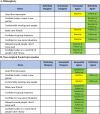Measuring the Impact of Surgical and Non-surgical Facial Cosmetic Interventions Using FACE-Q Aesthetic Module Scales: A Systematic Review and Meta-Analysis
- PMID: 39553513
- PMCID: PMC11562317
- DOI: 10.1177/22925503231225480
Measuring the Impact of Surgical and Non-surgical Facial Cosmetic Interventions Using FACE-Q Aesthetic Module Scales: A Systematic Review and Meta-Analysis
Abstract
Background: The FACE-Q Aesthetic module measures patient-important outcomes following surgical and non-surgical facial cosmetic procedures. Objective: The primary aim of this systematic review was to summarize the pre- to post-intervention mean differences of facial aesthetic interventions that evaluate outcomes using the FACE-Q Face Overall, Psychological, and Social scales. Methods: Ovid Medline, Embase, Cochrane, and Web of Science databases were searched on December 20, 2022 with the assistance of a health-research librarian (CRD42023404238). Studies that examined any surgical or non-surgical facial aesthetic intervention in adult patients and used FACE-Q Aesthetics Face Overall, Psychological, and/or Social scales to measure participants before and after treatment were included for analysis. Results: Of 914 potential articles screened, 35 studies met the inclusion criteria. Most studies evaluated surgical (n = 22, 62.9%) versus non-surgical facial cosmetic interventions (n = 13, 37.1%). Rhinoplasty [37.0 points, 95% CI 24.7-49.3, P < 0.01] demonstrated the largest weighted increase in Face Overall scores, whereas the largest increase in Psychological [67.1 points, 95% CI 62.9-71.3, P < 0.01] and Social [63.9 points, 95% CI 53.2-74.6, P < 0.01] scores was demonstrated by a single study evaluating surgical forehead lifts, respectively. Conclusions: This meta-analysis leverages FACE-Q Aesthetic module scoring to present the expected mean differences in Face Overall, Psychological, and Social scale scores for various surgical and non-surgical facial cosmetic interventions. The findings from this review may be used to indirectly compare interventions and contribute to sample size calculations when planning future studies.
Historique: Le module esthétique FACE-Q mesure les résultats importants pour le patient après des interventions esthétiques chirurgicales et non chirurgicales du visage. Objectif: L’objectif primaire de la présente analyse systématique consistait à résumer les différences moyennes d’interventions esthétiques du visage avant et après l’opération, dont les résultats étaient évalués à l’aide des échelles globales, psychologiques et sociales de l’esthétique faciale FACE-Q. méthodologie: Le 20 décembre 2022, les chercheurs ont fouillé les bases de données Ovid Medline, Embase, Cochrane et Web of Science avec l’aide d’un bibliothécaire spécialisé en recherche en santé (CRD42023404238). Les études qui portaient sur toute intervention esthétique chirurgicale ou non chirurgicale du visage chez des patients adultes et qui faisaient appel aux échelles globales, psychologiques ou sociales de l’esthétique faciale FACE-Q pour mesurer les participants avant et après leur traitement ont été incluses dans l’analyse. Résultats: Sur les 914 articles potentiels extraits, 35 études respectaient les critères d’inclusion. La plupart évaluaient les interventions esthétiques chirurgicales (n = 22, 62,9%) du visage par rapport aux interventions non chirurgicales (n = 13, 37,1%). La rhinoplastie [37,0 points, IC à 95%, 24,7 à 49,3, P < 0,01] a obtenu la plus forte progression pondérée des scores globaux totaux, tandis que la plus forte progression des scores psychologiques [67,1 points, IC à 95%, 62,9 à 71,3, P < 0,01] et sociaux [63,9 points, IC à 95%, 53,2 à 74,6, P < 0,01] a été établie par une seule étude évaluant les redrapages du front. Conclusion: La présente méta-analyse a tiré parti des scores du module esthétique FACE-Q pour présenter les différences moyennes anticipées des scores des échelles globales, psychologiques et sociales de diverses interventions esthétiques chirurgicales et non chirurgicales du visage. Les observations tirées de la présente analyse pourraient être utilisées pour procéder à une comparaison indirecte des interventions et contribuer aux calculs des tailles d’échantillons lors de la planification de prochaines études.
Keywords: Aesthetics; FACE-Q; meta-analysis; systematic review.
© 2024 The Author(s).
Conflict of interest statement
The authors declared no potential conflicts of interest with respect to the research, authorship, and/or publication of this article.
Figures










Similar articles
-
Face-down positioning or posturing after macular hole surgery.Cochrane Database Syst Rev. 2023 Nov 21;11(11):CD008228. doi: 10.1002/14651858.CD008228.pub3. Cochrane Database Syst Rev. 2023. PMID: 37987517 Free PMC article.
-
Music interventions for improving psychological and physical outcomes in people with cancer.Cochrane Database Syst Rev. 2021 Oct 12;10(10):CD006911. doi: 10.1002/14651858.CD006911.pub4. Cochrane Database Syst Rev. 2021. PMID: 34637527 Free PMC article.
-
Systemic pharmacological treatments for chronic plaque psoriasis: a network meta-analysis.Cochrane Database Syst Rev. 2021 Apr 19;4(4):CD011535. doi: 10.1002/14651858.CD011535.pub4. Cochrane Database Syst Rev. 2021. Update in: Cochrane Database Syst Rev. 2022 May 23;5:CD011535. doi: 10.1002/14651858.CD011535.pub5. PMID: 33871055 Free PMC article. Updated.
-
Drugs for preventing postoperative nausea and vomiting in adults after general anaesthesia: a network meta-analysis.Cochrane Database Syst Rev. 2020 Oct 19;10(10):CD012859. doi: 10.1002/14651858.CD012859.pub2. Cochrane Database Syst Rev. 2020. PMID: 33075160 Free PMC article.
-
Technological aids for the rehabilitation of memory and executive functioning in children and adolescents with acquired brain injury.Cochrane Database Syst Rev. 2016 Jul 1;7(7):CD011020. doi: 10.1002/14651858.CD011020.pub2. Cochrane Database Syst Rev. 2016. PMID: 27364851 Free PMC article.
References
-
- Qportfolio. FACE-Q | Aesthetics - Q-Portfolio MEASURING WHAT MATTERS TO PATIENTS. Accessed May 20 2023, https://qportfolio.org/face-q/aesthetics/.
LinkOut - more resources
Full Text Sources
Miscellaneous
